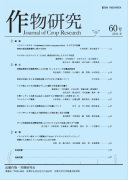Volume 60
Displaying 1-10 of 10 articles from this issue
- |<
- <
- 1
- >
- >|
Review Articles
-
Article type: Article
2015Volume 60 Pages 1-12
Published: 2015
Released on J-STAGE: March 01, 2017
Download PDF (1097K) -
Article type: Article
2015Volume 60 Pages 13-17
Published: 2015
Released on J-STAGE: March 01, 2017
Download PDF (3233K)
Research Articles
-
Article type: Article
2015Volume 60 Pages 19-22
Published: 2015
Released on J-STAGE: March 01, 2017
Download PDF (2994K) -
Article type: Article
2015Volume 60 Pages 23-26
Published: 2015
Released on J-STAGE: March 01, 2017
Download PDF (3442K) -
Article type: Article
2015Volume 60 Pages 27-30
Published: 2015
Released on J-STAGE: March 01, 2017
Download PDF (3125K) -
Article type: Article
2015Volume 60 Pages 31-35
Published: 2015
Released on J-STAGE: March 01, 2017
Download PDF (4135K) -
Article type: Article
2015Volume 60 Pages 37-42
Published: 2015
Released on J-STAGE: March 01, 2017
Download PDF (4557K) -
Article type: Article
2015Volume 60 Pages 43-46
Published: 2015
Released on J-STAGE: March 01, 2017
Download PDF (3031K) -
Article type: Article
2015Volume 60 Pages 47-53
Published: 2015
Released on J-STAGE: March 01, 2017
Download PDF (5034K)
Short Communication
-
Article type: Article
2015Volume 60 Pages 55-57
Published: 2015
Released on J-STAGE: March 01, 2017
Download PDF (2343K)
- |<
- <
- 1
- >
- >|
